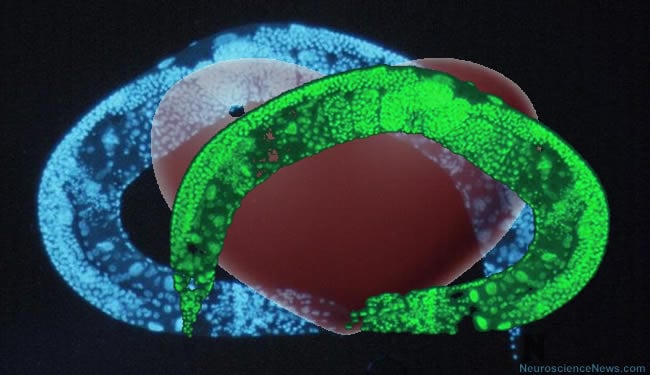In a study published today online in Science, researchers at Albert Einstein College of Medicine of Yeshiva University have determined the complete wiring diagram for the part of the nervous system controlling mating in the male roundworm Caenorhabditis elegans, an animal model intensively studied by scientists worldwide.
The study represents a major contribution to the new field of connectomics – the effort to map the myriad neural connections in a brain, brain region or nervous system to find the specific nerve connections responsible for particular behaviors. A long-term goal of connectomics is to map the human “connectome” – all the nerve connections within the human brain.
Because C. elegans is such a tiny animal – adults are one millimeter long and consist of just 959 cells – its simple nervous system totaling 302 neurons make it one of the best animal models for understanding the millions-of-times-more-complex human brain.
The Einstein scientists solved the structure of the male worm’s neural mating circuits by developing software that they used to analyze serial electron micrographs that other scientists had taken of the region. They found that male mating requires 144 neurons – nearly half the worm’s total number – and their paper describes the connections between those 144 neurons and 64 muscles involving some 8,000 synapses. A synapse is the junction at which one neuron (nerve cell) passes an electrical or chemical signal to another neuron.

“Establishing the complete structure of the synaptic network governing mating behavior in the male roundworm has been highly revealing,” said Scott Emmons, Ph.D., senior author of the paper and professor in the department of genetics and in the Dominick P. Purpura Department of Neuroscience and the Siegfried Ullmann Chair in Molecular Genetics at Einstein. “We can see that the structure of this network has spatial characteristics that help explain how it exerts neural control over the multi-step decision-making process involved in mating.”
In addition to determining how the neurons and muscles are connected, Dr. Emmons and his colleagues for the first time accurately measured the weights of those connections, i.e., an estimate of the strength with which one neuron or muscle communicates with another.
Notes about this neural network and connectome research
The research was supported by the Medical Research Council (U.K.); the National Institute of Mental Health (R21MH63223) and the Office of Behavioral and Social Sciences Research (OD010943), both of the National Institutes of Health; and the G. Harold and Leila Y. Mathers Charitable Foundation.
Contact: Deirdre Branley – Albert Einstein College of Medicine
Source: Albert Einstein College of Medicine of Yeshiva University press release
Image Source: C. elegans love image was created using public domain images and no artistic talent. Feel free to use.
Original Research: Abstract for “The Connectome of a Decision-Making Neural Network” by Travis A. Jarrell, Yi Wang, Adam E. Bloniarz, Christopher A. Brittin, Meng Xu, J. Nichol Thomson, Donna G. Albertson, David H. Hall, Scott W. Emmons in Science 27 July 2012 Vol. 337 no. 6093 pp. 437-444 doi: 10.1126/science.1221762







